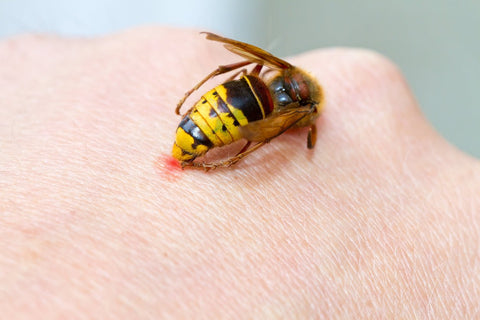- Removal of the stinger: If the stinger/insect is still in the sting site, it is important to remove it immediately.
It is important not to apply pressure to the stinger to avoid pushing more venom into the body.
-
Disinfect: Disinfect the sting site. Hand disinfectant gels, which are available in all drugstores and ideally always carried in your pocket or backpack during summer, are suitable for this.
-
Cooling: Immediately cool the sting with ice or cold compresses to reduce swelling.
-
Antihistamines: These can help to alleviate the reaction to the sting.
-
Local treatment with ointments: Cortisone-containing ointments reduce local reactions from insect stings. However, these should only be applied after disinfection and cooling.
-
Onion: Cut an onion in half and place the cut side with slight pressure on the sting site. The juice of the onion relieves itching, is antibacterial, and reduces swelling.
-
Medical help: In case of allergic reactions or stings in the mouth or throat area, you should seek medical help immediately or call emergency number 112 right away.
-
Do not stay alone: If you are out without company, try to find other people to be with you so you can get help in an emergency.
HeatPens work by applying targeted heat to the insect sting. They generate a localized heat of about 50-53 degrees Celsius, which is applied to the affected area for a few seconds.
As the use of so-called "HeatPens" is becoming more popular, we explain here again the mode of action and application.
These small, portable devices (heat pen, HeatPen) use heat to reduce discomfort after an insect sting. But how exactly do HeatPens work and how should they be used correctly?
Destruction of proteins:
The main mechanism of action is based on the denaturation of the proteins injected into the skin by the insect sting. These proteins, such as histamines in mosquito bites, are responsible for itching and the inflammatory reaction. The heat from the HeatPen destroys these proteins, thereby reducing the body's reaction to the sting.
Pain relief:
The application of heat can also affect the pain receptors in the skin. The heat can provide temporary pain relief by numbing the nerve endings and thus reducing the sensation of pain.
Use of HeatPens
1. Immediate application:
To achieve the best results, the HeatPen should be applied as soon as possible after the sting. This prevents the proteins from spreading and worsening the inflammatory reaction.
2. Targeted application:
Place the HeatPen directly on the sting and activate the device. The application usually takes only a few seconds, often between 3 and 10 seconds, depending on the device and manufacturer specifications.
3. Repeating the application:
If the itching or pain does not completely disappear after the first application, the treatment can be repeated after a short break. However, it is important to follow the manufacturer's instructions to avoid skin irritation from excessive heat exposure.
Advantages of using the HeatPen
Quick relief:
Immediate application of heat can quickly relieve the symptoms of an insect sting, often within minutes.
No chemical substances:
Unlike creams and gels that contain chemical agents, the HeatPen works purely mechanically with heat and is therefore also suitable for sensitive skin.
Portability:
HeatPens are small and lightweight, making them ideal for on the go. They can easily be carried in a pocket or backpack.
Reusability:
A HeatPen is reusable and has a long lifespan, making it a cost-effective solution for treating insect stings.
Alternative to the HeatPen:
If you do not carry a HeatPen and have been stung, heat (do not overheat!) a metal coffee spoon and press the heated spoon onto the sting site (observe hygiene measures). The spoon must not cause burns but must be hot enough to achieve the desired effect (slight pain when applied).






